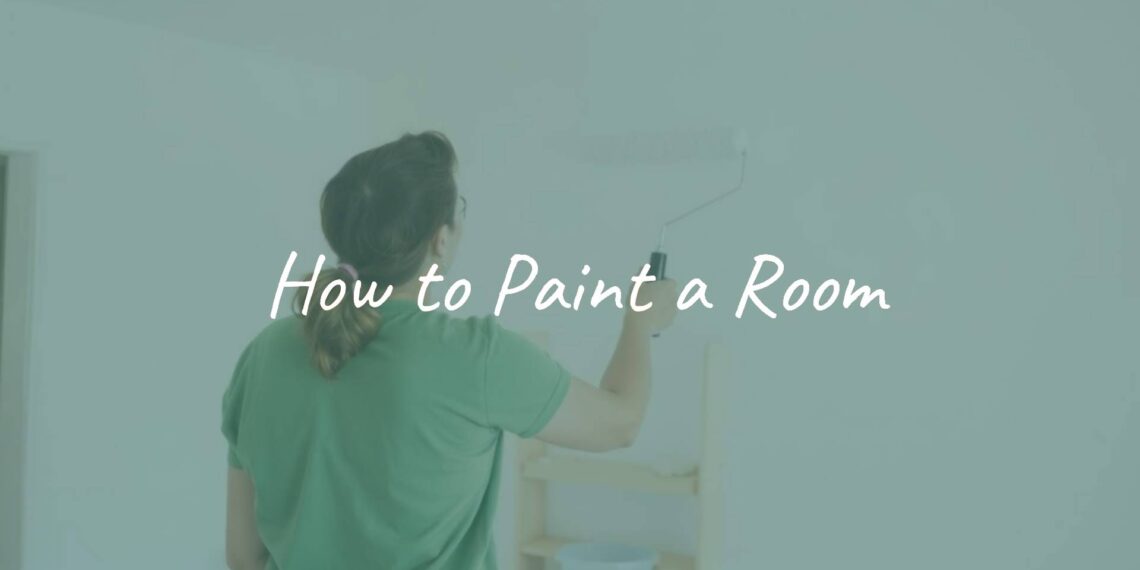Painting a room can feel like a big job, but it’s one of the most satisfying home projects you can do. With a little guidance, the steps are simple, and the change to your space is fast and rewarding. Whether you’ve done DIY work before or you’re new to it, learning how to paint a room will save money, let you pick your own style, and give you a strong sense of achievement.
This step-by-step guide walks you through everything from picking colors and gathering tools to the final cleanup, so your room looks neat and lasts. Get ready to tap into your inner artist and give your space a fresh look!
Why Paint a Room?
For many homeowners, painting is a basic part of caring for or updating a home. It’s often the first step when changing a room, and for good reason. A new coat of paint can change the mood and look of a space without spending a lot.
Besides the visual change, there are many practical upsides to doing it yourself. You’ll see clear results, grow your DIY confidence, and make your home feel more personal.

What Are the Benefits of Painting a Room Yourself?
DIY painting is about more than saving money, though that’s a nice bonus. Doing it yourself gives you control from color choice to the final coat. You get to adjust the process to your taste in a way that’s harder when hiring out.
Painting also costs less than many other projects, and mistakes are usually easy to fix. It’s a low-risk, high-reward project that’s great for beginners. Standing back and seeing a room you changed yourself is a great feeling.
How Can a Fresh Coat of Paint Improve a Living Space?
Fresh paint can brighten a small room so it feels larger and lighter, or add warmth to a big, echoing space. Color affects mood and can even suggest extra detail where there isn’t any. For example, Alexander Gorlin used Parma Gray by Farrow & Ball on an accent wall in a New York apartment to shape the feel of the room, while J.J. Martin’s custom coral in her Milan living room created a lively vibe.
Paint also helps protect walls, hides marks, and can help indoor air quality if you choose low or zero VOC formulas. The room won’t just look better; it will feel cleaner and more in line with your style.
What Tools and Materials Do You Need to Paint a Room?
Before you start, gather the right tools. Having everything ready makes the job smoother and helps you get a better finish. Cheap tools can lead to streaks, lint, and extra work later.
You can find most items at any home center. Spending a little more on brushes and rollers often leads to a cleaner result.
Paint Types and Sheens
Pick paint by both type and sheen. For interior walls, acrylic latex (water-based) is popular because it’s easy to clean up and works well on most walls. Sheen affects both look and durability.
| Sheen | Look | Best For | Pros/Trade-offs |
|---|---|---|---|
| Flat/Matte | No shine | Ceilings, low-traffic rooms | Hides flaws well; harder to clean |
| Eggshell | Soft glow | Living rooms, bedrooms | Balances look and cleanability |
| Satin | Light sheen | Halls, family rooms | Durable and easy to wipe |
| Semi-gloss | Noticeable shine | Kitchens, baths, trim, doors | Very durable; shows wall flaws |
| High gloss | Very shiny | Trim, doors, cabinets | Super tough; highlights imperfections |
Recommended Painting Tools and Supplies
- Paint, trays, and tray liners
- Stir sticks and a paint can opener
- High-quality angled brush (great for cutting in)
- Roller frames and covers (nap matched to wall texture)
- Ladder or step stool; roller extension pole
- Painter’s tape
- Drop cloths (canvas) and/or plastic sheeting
- Safety gear: goggles, gloves, particulate mask
- Rags, bucket, mild detergent, and cleaning supplies
- Primer (as needed)

Pros often suggest spending more on brushes and rollers to avoid streaks and lint.
Specialty Items: Painter’s Tape, Primers, and Drop Cloths
These items protect surfaces and help you get straight lines. Painter’s tape blocks off trim, baseboards, windows, and doors. Choose the right tack level for your surfaces and press it down firmly to stop seepage.
Primer helps paint stick, covers stains or dark colors, and sets a smooth base. Pick a primer for your surface type (new drywall, glossy paint, bare wood, etc.). Use canvas drop cloths for durability and absorption; use plastic sheeting if you’re on a tight budget. Cover furniture fully and tape the covering in place.
How to Choose the Right Paint for a Room
Picking paint is about more than choosing a color chip. Light, durability, and safety all affect the final look and how long it lasts. A little planning now can prevent redo work later.
Think about how the room is used, how light hits the walls, and how the color fits with furniture and decor.
Factors to Consider When Choosing Paint Colors
Color sets the tone. Light colors can make a room feel bigger and brighter, as Brian Kemnitz of Pearl Painters notes. Dark colors can make spaces feel cozy. Match your choice to your furniture, flooring, and lighting.
Always test samples on your walls. Colors shift under different light. Tim Bosveld of Dunn Edwards suggests looking at samples at several times of day under both natural and artificial light. Don’t rush; a few sample swatches can save you from repainting.
Primer vs. Paint-and-Primer-in-One
Combo products can work on clean, already painted walls with small color changes. But a separate primer usually works better on new drywall, patched areas, slick surfaces, stains, or big color changes. If you’re going dark, ask for a tinted primer (about 80% of the topcoat color) to improve coverage and depth.
How Paint Sheen Affects Appearance and Durability
Sheen affects both look and how well walls hold up to cleaning. Flat/matte hides flaws but doesn’t clean easily. Eggshell and satin clean better and are common in living areas and bedrooms. Semi-gloss and high gloss are very durable and easy to scrub, making them good for kitchens, baths, trim, and doors-but they show imperfections, so prep the surface well.
What to Know About VOCs and Paint Safety
VOCs are chemicals that can off-gas and cause headaches or irritation. For healthier air, choose low or zero VOC paints; Mauro Henrique from This Old House suggests 50 g/L or less. Keep windows open and use fans while painting. Wear goggles, gloves, and a particulate mask.
How to Prepare a Room for Painting
The secret to a pro-looking finish is careful prep. This part might feel tedious, but it matters most. Good prep helps paint go on smoothly, keeps drips off surfaces, and saves time later. As Tim Bosveld says, good prep makes the job easier and helps you get the results you want.
Think of it as building a good base. If you skip steps now, flaws will show up later.
Clearing the Room and Moving Furniture
Clear the space. Remove wall art and small items. Move big furniture out of the room or to the center, then cover it with plastic or old blankets. This protects pieces and gives you room to move, which is important for safe, efficient work.
Paint can travel, so cover more than you think you need to. Keep pets and kids away from the work area.
Protecting Floors, Fixtures, and Trim
Cover floors fully with drop cloths or plastic. For a safer walking surface, put canvas over plastic in busy areas. Tape edges to baseboards to block gaps where paint could sneak through.
Remove outlet covers and switch plates. If you can’t remove a fixture, wrap it in plastic and tape it tight. For windows, use painter’s tape around frames or use a glass-masking liquid for a clear, no-bleed barrier, as Mauro Henrique recommends.
Removing Outlet Covers, Switch Plates, and Hardware
Skip taping around these pieces-take them off instead. Use a screwdriver to remove covers, curtain brackets, and similar hardware. Store screws and covers in labeled bags so you can reattach them easily later. This leads to cleaner lines and full coverage under the hardware.

Repairing and Cleaning Walls
Inspect walls and fix holes, dents, and cracks. Use spackle for small holes and a patching compound or caulk for larger issues. After it dries, sand smooth with fine-grit paper (about 220). You want an even surface so flaws don’t show through.
After sanding, clean the walls. Wipe away dust, grease, and dirt with a damp cloth or mild detergent. Rinse and let dry fully. Clean walls help paint stick and last.
Masking Windows, Doors, and Baseboards
Apply painter’s tape along the edges of windows, doors, and baseboards right at the trim line, parallel to the wall. For textured ceilings, run a screwdriver along the edge to make a thin smooth strip for the tape to grab. Press the tape down firmly with a putty knife, card, or your finger to seal the edge and stop bleed-through.
What Steps Are Involved in Painting a Room?
With prep done, it’s time to put paint on the walls. Follow these steps to get even coverage and a clean finish. The order matters, and patience pays off.
Work methodically and you’ll avoid most common mistakes.
Mixing Paint Thoroughly
Mix your paint before you start. Even new cans can separate. Proper mixing gives an even color and texture. Stir with a clean stick, scraping the bottom and sides. A paint store can shake the can for you, or you can use a drill with a paint paddle if the paint has sat for a long time.
Priming Walls for Better Paint Adhesion
Primer helps paint grip, evens out porous areas, and blocks stains. It’s especially helpful on new drywall, patched sections, glossy surfaces, and big color changes. Cut in around edges with an angled brush, then roll larger areas in 3-by-3-foot sections using W or V strokes. One coat is often enough, but very dark colors may need a second coat of primer.
Cutting In Around Edges and Corners
Cutting in means brushing neat lines where rollers can’t reach: along ceilings, baseboards, door and window frames, and corners. Load an angled brush lightly and make a 1.5- to 2-inch band of paint around the room. Use steady, long strokes. If you taped, paint up to the tape edge without pushing paint under it.

Rolling Paint on Large Surfaces
Pour paint into a lined tray and load the roller evenly. Roll in a “W” or “M” pattern to spread paint, then fill in. Start high and work down, overlapping by about one-third. Keep pressure even. After each section, make one light, smooth pass from top to bottom to level the coat and catch drips. Blend sections while the paint is still wet to avoid lap marks.
How Many Coats Should You Apply?
Plan on at least two coats for a rich, even finish. Big color changes may need a third coat, especially without a tinted primer. Don’t try to do one thick coat-thin, even coats look better and dry more reliably.
How Long Does Paint Take to Dry Between Coats?
Most latex paints are dry to the touch in a couple of hours, but that’s only surface dry. For best results, wait two to four hours between coats, longer if the room is cool or humid. Check the label for the brand’s recommendation. Give yourself extra time rather than rushing and risking peeling or uneven coverage.
Which Painting Techniques Lead to Best Results?
Good technique helps you avoid lines, drips, and uneven spots. The right tools and a steady method make the job faster and cleaner.
Use the tips below to level up your finish without adding much time.
When to Use Brushes, Rollers, or Sprayers
Use brushes for detail work and edges. An angled brush is great for cutting in. Use rollers for big, flat areas like walls and ceilings. Match roller nap to the surface: low nap for smooth walls, thicker nap for textured walls. Sprayers can be fast for large areas or for furniture and cabinets, but they need extra masking and practice to avoid drips. For most rooms, brushes and rollers are enough.
How to Avoid Streaks, Drips, and Lap Marks
- Don’t overload brushes or rollers; excess paint causes drips.
- Keep a wet edge by overlapping into the last painted area while it’s still wet.
- Use steady, even pressure-pressing too hard makes ridges.
- When cutting in, wipe off extra paint and use controlled strokes.
- Wipe drips right away with a damp rag.
- Always use thin, even coats instead of one heavy coat.
Painting Trim, Windows, and Doors
For trim, use a quality brush and long, smooth strokes. Paint crown molding first, then door/window frames, and finish with baseboards. Load the brush moderately to reduce drips.
For windows, start with the top sashes. Use an angled sash brush for edges next to the glass, then paint the faces. Move to the bottom sashes. For doors, it’s easier to remove them and paint flat on sawhorses: panels first, then horizontals, then verticals. If painting in place, follow the same order and watch the edges and hardware.
How to Tidy Up After Painting a Room
You’ve handled the planning, prepped the space, and applied each coat with care. Now finish strong with a clean, orderly wrap-up. Good cleanup saves your tools and leaves the room ready to use.
Taking a bit of extra time here protects your work and makes the final reveal feel great.
Cleaning Brushes, Rollers, and Trays
For latex paint, wash brushes and rollers with warm, soapy water until it runs clear. Spin rollers to remove water and reshape brush bristles before air-drying. For oil-based paint, use mineral spirits or paint thinner as directed and work with plenty of fresh air. Tray liners make cleanup easy-just toss them. If not using liners, wash trays with the right cleaner for your paint type.
Properly Disposing of or Storing Leftover Paint
Seal leftover paint tightly and store it in a cool, dry place. Tap the lid on firmly with a rubber mallet. Some people store cans upside down to help keep air out. Only toss empty cans if the residue is fully dry.
Never pour liquid paint down drains or outside. Take leftover paint to a paint store or a hazardous waste site. Buy close to what you need, plus a little extra for touch-ups, to reduce waste.
Removing Tape and Drop Cloths Without Damaging Surfaces
Pull painter’s tape while the paint is slightly tacky, not fully dry. Peel at a 45-degree angle, slowly. If paint has dried on the tape, score the edge lightly with a utility knife before pulling.
Roll up drop cloths and plastic carefully. For dried drips on hard floors, use a painter’s knife gently or a small amount of paint thinner on a cloth, taking care not to harm the surface.
How Long to Cure Paint Before Replacing Furniture
Paint can feel dry in hours but needs days to harden. Most latex paints cure in a few days to two weeks. During this time, the finish is softer and easier to mark.
Wait at least a couple of days before pushing furniture back or hanging art. Keep the room well-ventilated to help fumes clear and paint harden. Treat the walls gently in the first weeks for the longest-lasting result.
Troubleshooting Common Painting Problems
Even careful painters hit a few bumps. Most issues are fixable, and knowing why they happen helps you stop them next time. Don’t let a small flaw overshadow your work-quick fixes can bring the finish back.
Below are common problems and simple solutions.
How to Fix Uneven Coverage or Missed Spots
If you see light areas or “holidays,” add another thin, even coat. Plan for two coats from the start. For small missed spots, touch up with a small brush using paint from the same can to avoid slight color shifts.
To prevent this, keep the roller loaded, overlap strokes by about one-third, and work with good lighting. Step back often to check your work from different angles.
What Causes Peeling or Bubbling Paint?
Poor adhesion is the usual cause. Peeling can happen if you paint over dirt, grease, or loose old paint. Moisture problems also break the bond. Bubbles can appear if you paint over a damp or dirty surface, apply a second coat too soon, or paint in direct heat or sun.
Fix by scraping off loose paint, cleaning and sanding, then re-priming and repainting. Allow proper dry times at each step.
How to Perform Touch-Ups Without Noticeable Seams
Touch-ups can flash (look different) because of sheen or slight color change. Use the exact same paint and mix it well. For tiny spots, use a small artist’s brush or cotton swab and feather the edges. For bigger areas, lightly sand, clean, then use a mini-roller to blend. Flat and matte are easier to touch up than shinier finishes.
Frequently Asked Questions about Painting a Room
Here are clear answers to common questions about timing, order, and what to do with old paint and wallpaper.
Use these tips to plan your project with confidence.
How Long Does It Take to Paint an Average Room?
Time depends on room size, prep needs (repairs, cleaning, masking), number of coats, and your pace. While some say 2-4 hours, that often means just the rolling time. A realistic DIY timeline for a full room-including prep, two coats with dry time, and cleanup-often takes a weekend. Casey Finn of The DIY Playbook suggests one day for prep and primer, and one day for paint and cleanup. Don’t rush drying times.
Should You Paint the Ceiling or Walls First?
Most pros paint the ceiling first, then the walls, then the trim. Gravity makes ceiling work messy, so any drips on the walls get covered when you paint the walls. Finishing with trim lets you cover any wall paint that got on it earlier. This top-to-bottom order reduces extra masking and touch-ups.
Can You Paint Over Old Paint or Wallpaper?
Yes, you can paint over old paint if it’s in good shape. Clean the surface and lightly sand glossy areas so the new coat sticks. If the old paint is peeling or bubbling, scrape off loose bits, sand smooth, clean, then prime and repaint.
Painting over wallpaper isn’t a good idea. Moisture from paint can lift the paper. It’s better to remove wallpaper first. In homes built before 1978, test for lead paint before sanding and follow EPA rules if lead is present.














![What to with Scrap Metal? [infographic]?](https://facts-homes.com/wp-content/uploads/2019/07/645413-POPYOV-391-120x86.jpg)





